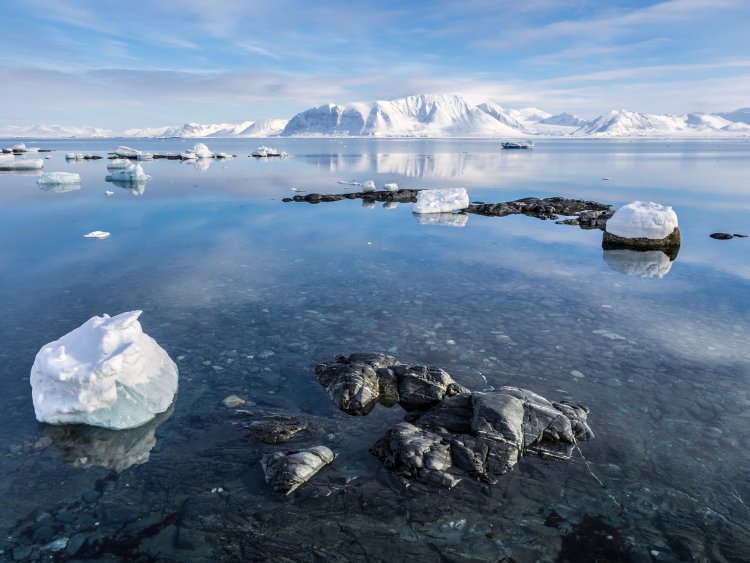An iceberg, the world’s biggest one at present, has split off the Antarctic coast. It can house 1.5 areas of Moscow, 3 cities like St. Petersburg, or 5 cities like Volgograd. The elongated ice island has 170 km in length and 25 km in width. Its area is 4,320 km2. The iceberg received the name of A-76. Like the previous record holder, A-23A, it still remains in the Weddell Sea.
However, A-76 I not the biggest iceberg ever. B-15, which split off the Ross glacial shelf in 2000, exceeded the present one 2.5 times in area. By today, it has broken into pieces almost completely and melted. The fate of A-76 will be presumably the same.
The density is 920 kg/m³ for ice and 1,025 kg/m³ for sea water, so 9/10 of the iceberg are under water, and only 1/10 of it is on the surface. Usually, icebergs chip off the shelf glaciers, and there is nothing strange that once they put out to see on their own. “Each glacier is moving being exposed to ice gravity force. Fundamentally, the Antarctic is a sort of dome in shape, so the ice flows down from its top. There’s absolutely nothing strange. Many gigantic icebergs have split off the coast within my memory,” head specialist of the Earth Science Department at the Russian Academy of Sciences, doctor of geography Nina Zaytseva says.
If compared to A-76, the iceberg that drowned Titanic was a small kid, though the size of that iceberg was enough to drown a steel liner in 1912. It is for the navigation that icebergs pose the greatest threat: slowing down is mandatory for the ships when they enter the waters where icebergs are floating.
The marine services try to prevent collision with icebergs. They monitor the icebergs’ movement and warn the ship crews about possible danger. However, the weather often makes it difficult to monitor the icebergs’ movement, as they usually drift in the areas with adverse meteorological conditions. Orbital survey is the main method of observation: an iceberg over 20 m long can be detected in the area of 2,500 km2 with the help of one snapshot.
The icebergs are towed sideways to make navigation areas safe and prevent their collision with marine oil rigs. However, it is not an easy task due to the block instability and melting of ice. An iceberg is a potential source of fresh water. The possibility of transporting them to the arid regions of the planet is being discussed today. Such an idea was suggested about 200 years ago, but it has yet failed to be put into practice. The French scientists have calculated that it will take 141 days to deliver an iceberg weighing up to 7 million tons from the coast of Newfoundland to the Canary Islands. The amount of ice is enough to meet the needs of 35,000 people during one year.
On March 19, 1952, American pilot Joseph Fletcher landed his C-47 airplane on the iceberg with the area of 90 km2. The crew founded a research station there, and this station remained inhabited for 22 years. The station’s initial name T-3 was replaced with Fletcher’s Ice Island. It is not a singular case, as inhabited research bases are built on icebergs. They are used as piers for procurement of Antarctic stations. Such an approach is taken advantage of, when ice conditions do not let the ship to moor to the barrier, while the collar ice is either missing or not strong enough. In such a case, the vessel moors to a table-like iceberg, while planes and helicopters take people and cargos from it.
The scientists can forecast the appearance of new icebergs. Before the split-off the glacier would grow. When the critical mass is achieved, the glacier cracks, and a part of it chips off. For instance, the specialists expect a big iceberg to split off the Amery shelf glacier in the eastern part of Antarctic.
However, the Russian scientists do not associate the chip-off of A-76 with the problem of global warming. TASS quotes research fellow of Ice Conditions Forecasts Department at the Research Institute of Arctic and Antarctic Andrey Korotkov as saying: “There is no point in exaggerating the importance of this event and look for the reason behind it in the acceleration of Antarctic ice shield degradation or global warming. It is a natural phenomenon of cycling pattern. I mean that icebergs split off the glaciers that have grown to the limit approximately once in 60 years.”
Photo: erectus / ru.123rf.com






















